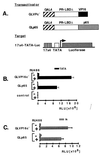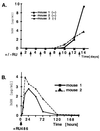Adenovirus-mediated regulable target gene expression in vivo
- PMID: 9892637
- PMCID: PMC15140
- DOI: 10.1073/pnas.96.2.355
Adenovirus-mediated regulable target gene expression in vivo
Abstract
To regulate expression of a transferred gene in response to an exogenous compound, we have combined a high capacity adenoviral vector devoid of all viral coding sequences with a regulatory system that can be used to express a target gene in vivo in a selected site and at a desired time. This system uses a chimeric transactivator, GLp65, which consists of a mutated progesterone receptor-ligand binding domain fused to the GAL4 DNA binding domain and part of the activation domain of the human p65 protein, a component of the NF-kappaB complex. In the presence of the antiprogestin mifepristone, this chimeric regulator binds to a target gene containing the 17-mer GAL4 binding site, resulting in an efficient ligand-inducible transactivation of the target gene. We inserted the regulator GLp65 and a regulable human growth hormone target gene containing the 17-mer GAL4 binding site into the same adenoviral vector. To obtain tissue-specific expression of the target gene, we coupled the regulator to a liver-specific promoter. Infection of HepG2 cells and experimental mice with the adenovirus resulted in consistently high induction levels of human growth hormone in the presence of mifepristone whereas the transgene expression was undetectable in the absence of the ligand. Taken together, our regulable adenoviral vector represents an important tool for transgene regulation that can be used for potentially diverse applications, ranging from tissue-specific gene expression in transgenic animals to human gene therapy.
Figures





Comment in
-
Development of optimized vectors for gene therapy.Proc Natl Acad Sci U S A. 1999 Jan 19;96(2):324-6. doi: 10.1073/pnas.96.2.324. Proc Natl Acad Sci U S A. 1999. PMID: 9892629 Free PMC article. No abstract available.
References
Publication types
MeSH terms
Substances
LinkOut - more resources
Full Text Sources
Other Literature Sources
Research Materials
Miscellaneous

